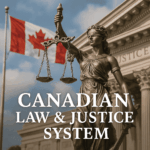If you want to comply effectively with law in Canada, it’s essential to grasp the fundamentals of criminal law. Recognizing the types of offenses, their classifications, and possible penalties helps individuals and legal professionals navigate the justice system confidently. Learning these core elements prevents unintentional violations and ensures fair treatment under the law.
Canadian criminal law primarily originates from the Criminal Code, which outlines what constitutes a crime and describes corresponding punishments. Familiarity with this code enables you to interpret legal situations accurately and understand your rights and responsibilities. It also clarifies how law enforcement and courts handle various offenses, from minor infractions to serious crimes.
Understanding the principles behind law helps in comprehending how justice is administered. Concepts like mens rea (intent) and actus reus (action) form the foundation for determining guilt. Knowing these principles can guide individuals in assessing their actions and seeking proper legal advice when needed, fostering a more informed approach to issues related to criminal conduct.
How Are Criminal Offenses Classified and What Are Their Penalties?
In Canada, criminal offences are primarily categorized into two classes: indictable offenses and summary conviction offenses. Indictable offences are more serious crimes, such as murder or treason, and generally carry heavier penalties. Summary conviction offences involve less severe misconduct, like petty theft or obstructing justice, and impose lighter punishments.
Classification and Severity
The classification depends on the crime’s nature and the relevant sections of the Criminal Code of Canada. For indictable offences, penalties can include lengthy prison sentences, fines, or both, reflecting the gravity of the offence. Summary conviction offences usually result in shorter jail terms–often up to six months–as well as fines or community-based sanctions.
Determining Penalties
The specific penalties for each offence are outlined in Canadian criminal law and can vary based on factors such as prior convictions, the circumstances of the crime, and whether the offender shows remorse or restitution. Courts consider these details to decide appropriate sentencing, balancing accountability with rehabilitation.
Overall, understanding how offences are classified helps individuals grasp potential consequences and guides legal processes in Canada. The system aims to match the penalty’s severity with the nature of the crime, ensuring fair treatment across different cases.
What Are the Legal Procedures for Defending Yourself in a Criminal Case?
If you face criminal charges in Canada, it is crucial to understand your rights and follow proper legal procedures. First, exercise your right to a lawyer by requesting legal representation immediately. A qualified criminal defence lawyer can guide you through the complex Canadian legal system and develop a strong defense strategy.
Next, you must be formally notified of the charges against you through a document called an information or indictment. At your first court appearance, you will be advised of your rights and asked to enter a plea, either guilty or not guilty. Pleading not guilty ensures your case proceeds to trial, where evidence will be examined.
During the trial process, both sides present evidence and call witnesses. You have the right to cross-examine the prosecution’s witnesses and present your own evidence. Your lawyer will help prepare your testimony and identify any legal objections to evidence or procedures that do not comply with Canadian criminal law standards.
If the evidence supports a conviction, the judge or jury will decide based on the standard of proof beyond a reasonable doubt. If found guilty, you will have opportunities for appeal or to seek sentencing alternatives. Throughout this process, adhere strictly to court protocols, respect hearing procedures, and communicate clearly with your legal team.
Be aware of deadlines for filing paperwork or notices, such as notices of appeal, as missing these can affect your rights. Following procedural rules precisely ensures your defense remains valid and that your rights are protected under Canadian law.
How Does the Canadian Justice System Handle Juvenile Crime Cases?
Follow the law by prioritizing rehabilitation over punishment in juvenile crime cases. Canadian courts focus on the best interests of the young person, aiming to guide them toward positive behavioral changes. This approach involves specialized procedures and laws tailored to minors.
Legal Framework and Procedures
The Youth Criminal Justice Act (YCJA) governs how the justice system handles offenders under 18. The law encourages diversion programs, which resolve cases without formal court proceedings, whenever appropriate. When a case proceeds to court, hearings are more informal than adult trials, allowing for a supportive environment that considers the juvenile’s age and circumstances.
Sentencing and Rehabilitation
Canadian law emphasizes rehabilitation and reintegration through tailored programs, community service, or supervised probation, rather than imprisonment. When detention is necessary, courts impose the least restrictive measures, constantly aiming to balance public safety with the young person’s development. The law mandates regular review of placements to encourage successful reintegration into society.

